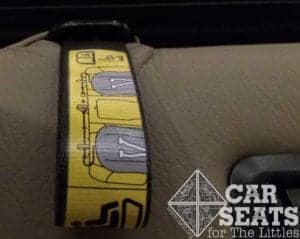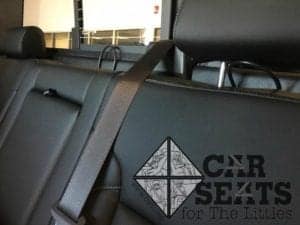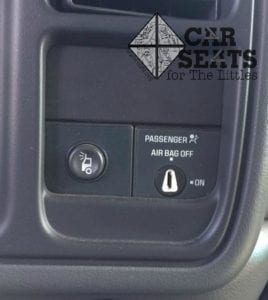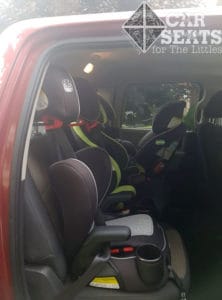
This Little is on his way to pick up his new goats!
When my kids get to go somewhere with their (admittedly super cool) uncle they yell: “Truck ride!” For my city kids it’s a treat to ride up high on the highway next to their cousin, but transporting families in pick-up trucks is standard in much of North America, and modern 4 door trucks can be comfortable and safe for kids and adults alike. When installing car seats some trucks have unique features, however. Let’s take a look at how installing child restraints in trucks differs from installing in cars.
Cab Style

Compact car seats like the Scenera NEXT fit on the shorter bench seats of some trucks
Trucks for the North American market often come in many different cab styles. While a single model of car may have a handful of trim levels, a single model of truck might have a handful of different cab styles with names like “extended cab”, “super cab”, and “crew cab.” These cab styles can make a big difference in terms of the proper fitting of car seats and boosters, in terms of the style and shape of the back seat and the amount of room for back seat riders.
Tether Style and Location

Image source: http://www.preventinjury.org/Child-Passenger-Safety/About-Child-Safety-Seats/Tethers
The tether is an essential part of every forward facing harnessed car seat; because tethers reduce head excursion (the distance the child’s head travels forward) in a crash by up to 6″, all forward facing car seats need to be tethered. The reduction in head excursion might be even more important in the smaller body of some trucks: 4-6″ might be the difference between a child’s head striking the seat in front of him and not.
Unfortunately, we know that tether usage in the United States is much lower than it should be. Fewer than 50% of car seats in use in the United States are tethered when they should be; those numbers are for all vehicles. Finding the tether anchor and using the top tether in cars tends to be somewhat easier than findng and using the tether anchor is in trucks.
Caregivers who are used to installing and using car seats in cars may find the tether anchors in trucks unfamiliar and difficult; unfortunately this may lead to an even lower usage rate of tethers in trucks. There are a few different designs for tether anchors in trucks, which will always be outlined in your vehicle’s manual in the child restraint section–as always when installing a car seat there are two manuals to follow: the car seat manual as well as the vehicle’s manual (and we always recommend meeting with a CPST in person if you’re learning to install your car seat in a new car or truck).
We also know that not every parent can meet with a CPST in person before they need to take their Littles on the road. Let’s outline a few possibile locations for tether anchors in trucks.
Tether Anchors Behind the Vehicle Seat

Tether location behind the seat in an extended cab, accessed by folding down the seat.
To access this kind of tether anchor the seat itself must fold up or down. Locating the anchor is your first job: always check the vehicle’s own manual for that. Some trucks will have tabs that pull the seat back forward, and some will require you to lift up the seat itself to access the tether anchors on the back wall. When you’re digging around in your manual, look as well to see how the tether strap should be routed with respect to the head restraint–some tethers go through and some need to be routed over or around. This type of tether anchor can be rather inconvenient for seats that must be moved daily: though it’s not impossible to install a forward facing seat, people shopping for a truck might want to keep this in mind.
Webbing Loops for Routing the Tether

Toyota Tundra tether loop
This style of anchor routes the tether for the side positions through a webbing loop directly behind the seating position on which the child restraint is installed. The tether then connects to a metal anchor behind a different position. For this type of tether, consult the vehicle’s manual for instructions since there are a few different ways trucks are configured.

This forward facing seat is tethered by routing the tether through the loop directly behind the child restraint, then hooking the tether on to the loop behind the adjacent seating location
In this example the tether anchor from the seat in the outside position is routed through a webbing loop behind the outside position and hooked behind the center position. When two forward facing car seats are installed on either side of the vehicle’s seat, hook the tether from both sides to this one anchor. Though it is essential in most cars that seats not share a tether anchor this type of truck is the exception.
Behind the Seat Loops as Anchors

The wire loops behind the seat in this extended cab are both the route for the tether and the tether anchor itself.
These anchors look particularly strange to people used to tether anchors in cars, but despite the design difference they too are an essential safety element of the car seat and truck. For most of these trucks the tether will be routed differently in the middle and side seats: it’s essential to consult your vehicle’s manual to make sure you’re using the tether correctly. Often for these trucks the tether is routed through a webbing loop directly behind the seat and hooked to a loop behind either the center seat or, for child restraints installed in the center position, to a loop behind the adjacent outboard position.
Vehicle Seat Style

The middle seat in this truck is much more shallow than the outboard seats: always check that your particular car seat will fit according to the manufacturer’s guidelines
Another challenge in some trucks is unique second row seating. Some trucks have sideways-facing seats: these are never safe to install car seats, as, like rear-facing vehicle seats, they are not approved by the child restraint manufacturers. Some middle seats in trucks are much more shallow than the side seats, and not all car seats allow for the child restraint to hang off the front: in this case you’ll need to consult the manual for your car seat to see how much overhang is allowed. Remember that choosing another seating location is an easy and free way to make a seat fit in a vehicle–if you have a truck with a shallow middle seat shuffling the seating so that the child restraint is installed outboard may be an option. Fold down seats may also be too shallow to install many car seats, and some trucks feature storage that may present difficulties.
Vehicles with One Row

A key turn off for a passenger side airbag. With the airbag turned off from this key, the front passenger side is an appropriate place to install a rear facing car seat.
Ideally, children will ride in proper restraints in the back seat of all vehicles. The back seat is the safest place for children under age 13. However, in trucks with only one row, that’s not a possibility. If a family must transport a child in a vehicle with only one row there are a few factors we need to consider. Does the airbag turn off with a key? Does the vehicle manufacturer have a prohibition on installing car seats in the front seat on the side or in the middle?Rear facing car seats must never be installed in front of an active airbag. This includes airbags that are linked to a weight sensor and programmed to go off differently for people of different weights: if a seat has an airbag a rear facing seat must not be installed there unless the airbag is turned off with a key. In the United States there are single cab trucks that feature an airbag turn off key and there are also those in which the airbag can not be turned off, so that key is, in fact, the key to determining if a truck is a safe way to transport a rear facing child.
No Safe Option Sometimes
Though it’s not good news, nor is it what any CPST wants to tell a parent, sometimes there is simply no safe way to transport a child in a particular vehicle. Newer one row trucks in the United S are not equipped with a key to turn off the passenger side airbags: no rear facing car seat can ever be installed in these trucks. Some of these trucks may outright prohibit children riding in the manual. Some trucks have a seat belt in the middle of the front row but the manual prohibits child restraints to be installed in that position. Again, consulting the vehicle’s manual is always the first step.
Trucks!
Trucks are many things: essential to work, fun for your city mouse cousins, a great way to go on vacation. As with all of child passenger safety, by paying attention to the details of both the vehicle’s own safety equipment and your car seat’s manual you can safely transport Littles of all sizes in trucks. They’re complicated, but man: they’re fun.

